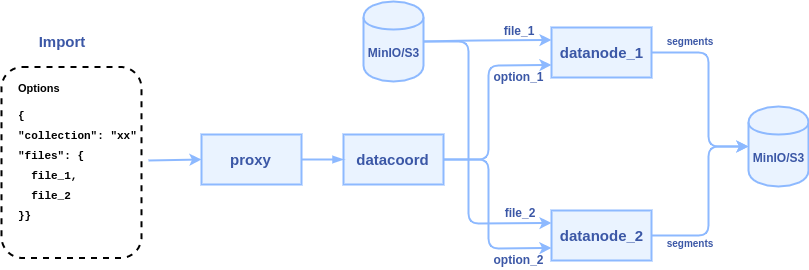Current state: Accepted
ISSUE: https://github.com/milvus-io/milvus/issues/15604
PRs:
Keywords: bulk load, import
Released: with Milvus 2.1
Authors:
Summary
Import data by a shortcut to get better performance compared with insert().
Motivation
- client calls insert() to transfer data to Milvus proxy node
- proxy split the data in do multiple parts according to sharding number of the collection
- proxy constructs a message packet for each part and send the message packets into the Pulsar service
- data nodes pull the message packets from the Pulsar service, each data node pull a packet
- data nodes persist data into segment when flush() action is triggered
Typically, it cost several hours to insert one billion entities with 128-dimensional vectors. Lots of time is wasted in two major areas: network transmission and Pulsar management.
We can see there are at least three times network transmission in the process: 1) client => proxy 2) proxy => pulsar 3) pulsar => data node
We need a new interface to do bulk load without network bandwidth wasting and skip the Pulsar management. Brief requirements of the new interface:
- import data from JSON format files. (first stage)
- import data from Numpy format files. (first stage)
- copy a collection within one Milvus 2.0 service. (second stage)
- copy a collection from one Milvus 2.0 service to another. (second stage)
- import data from Milvus 1.x to Milvus 2.0 (third stage)
- parquet/faiss/csv files (TBD)
To reduce network transmission and skip Plusar management, the new interface will allow users to input the path of some data files(json, numpy, etc.) on MinIO/S3 storage, and let the data nodes directly read these files and parse them into segments. The internal logic of the process becomes:
1. client calls import() to pass some file paths to Milvus proxy node
2. proxy node passes the file paths to data coordinator node
3. data coordinator node picks a data node or multiple data nodes (according to the sharding number) to parse files, each file can be parsed into a segment or multiple segments.
SDK Interfaces
The python API declaration:
def import(collection_name, files, partition_name=None, bucket=None, default_fields=None)
- collection_name: the target collection name (required)
- partition_name: target partition name (optional)
- files: a list of files with row-based format or a dict of files with column-based format (required)
- bucket: the MinIO/S3 bucket where the files come from, same with Milvus server bucket by default (optional)
- default_fields: a dict to set the default value for some fields (optional)
Pre-defined format for import files
Proxy RPC Interfaces
The declaration of import API in proxy RPC:
service MilvusService {
rpc Import(ImportRequest) returns (ImportResponse) {}
}
message ImportRequest {
common.MsgBase base = 1;
string options = 2; // options in JSON format
}
message ImportResponse {
common.Status status = 1;
repeated schema.IDs IDs = 2; // auto-generated ids for succeed chunks
uint32 succ_index = 3; // number of chunks that successfully imported
}
Datacoord RPC interfaces
The declaration of import API in datacoord RPC:
service DataCoord {
rpc Import(milvuspb.ImportRequest) (milvuspb.ImportResponse) {}
rpc CompleteImport(ImportResult) returns (common.Status) {}
}
message ImportResult {
common.Status status = 1;
schema.IDs IDs = 2; // auto-generated ids
repeated int64 segments = 3; // id array of new sealed segments
}
Datanode RPC interfaces
The declaration of import API in datanode RPC:
service DataNode {
rpc Import(milvus.ImportRequest) returns(common.Status) {}
}

